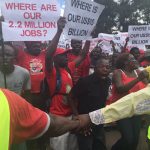These are some of the biggest projects announced to date:
- May 15, 2019: In an article headlined “UK beef giant takes over CSC,” the Herald said Zimbabwe’s state-owned cold-storage company would transfer its cattle ranches and abattoirs to Boustead Beef Ltd. for 25 years in exchange for it investing $130 million in the company and paying off debts of $42.5 million. ZwNews reported on the same day that the British firm is a “briefcase company” with no history of doing business. There is no record of Boustead on the UK’s companies register.
- April 23, 2019: Mines Minister Winston Chitando said an agreement has been signed with China’s Tsingshan Holding Group Co. to build a 1 million-metric-ton per year stainless-steel export facility in the landlocked country, as well as a power plant and a possible lithium mine at a total cost of $10 billion.
- April 10, 2019: Deputy Mines Minister Polite Kambamura said a deal had been signed with Russian investors to build a $4 billion platinum mine. The project is struggling to attract finance because potential backers are wary of the stake held by Zimbabwe’s military.
- 19, 2019: A venture between the Zimbabwean and Zambian governments said they’ve shortlisted bidding groups for a $4 billion hydropower plant on the Zambezi River.
- 1, 2018: Mnangagwa told reporters that Invictus Energy Ltd. had found oil and gas deposits in the country. The next day, Invictus said it hadn’t discovered oil.
- May 18, 2018: The Herald reported that South Africa’s Nkosikhona Holdings will build a $5.2 billion coal-to-fuel plant in Zimbabwe. A search of South Africa’s company records shows Nkosikhona has one director and an address in a light-industrial area.
- March 22, 2018: Zimbabwe signed a $4.2 billion deal with Karo Resources, a closely held Cyprus-based company, to build a platinum mine. On April 17, Mnangagwa tweeted that the project is moving ahead and will create 2,500 jobs. On May 15, Tharisa Plc, which has taken a stake in the project, said some drilling has started and the company is awaiting approval of its environmental-impact assessment study.
Zimbabwe has plenty to offer, with a cornucopia of minerals including the world’s third-biggest platinum-group-metal reserves, and some of the best transport infrastructure in the region. Local ownership rules have been relaxed, as has a currency regime that hindered access to dollars.
The RTGS$, a quasi-currency that isn’t used outside Zimbabwe, fell 30% on the three-month-old interbank market today to 4.55 per dollar, bringing it closer to the black market rate of 6.10. On May 18, the government said it had secured a $500 million loan backed by platinum exports that it would use to boost liquidity in the interbank market.
Still, a disputed 2018 election, in which Mnangagwa retained power, and the violent suppression of protests earlier this year have underscored the country’s instability.
Few companies with a “rational level of risk appetite” will invest in the country in its current state, said Jee-A van der Linde, an economist at NKC African Economics.
The African Development Bank estimated foreign direct investment last year at $470 million, about a third of the $1.1 billion attracted by northern neighbor Zambia and a fraction of the $2.3 billion that flowed into Mozambique, which lies to the east.
For some Zimbabweans, the investment pledges evoke memories of Mugabe, who was prone to announcing mega-deals that didn’t materialize. For example, in September 2017 Mugabe announced plans to revive Zimbabwe Iron & Steel Works Ltd., once the second-largest steelmaker in sub-Saharan Africa. The project never got off the ground.
“Mega-deals may be mega-deals, they may be mega-nonsense,” said Joe Chabikwa, who sells potted plants to passing motorists in the capital, Harare. “These days you believe what you see with your own eyes.”- Bloomberg
(165 VIEWS)


